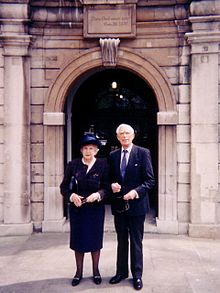Frederick Rosier
| Sir Frederick Rosier | |
|---|---|

Sir Frederick and Lady Rosier outside St Clement Danes (April 1995)
|
|
| Born |
13 October 1915 Wrexham, Wales |
| Died | 10 September 1998 (aged 82) Llangollen, Wales |
| Allegiance | United Kingdom |
| Service/branch | Royal Air Force |
| Years of service | 1935–73 |
| Rank | Air Chief Marshal |
| Commands held |
Fighter Command (1966–68) Air Forces Middle East (1961–64) RAF Horsham St Faith (1947–48) RAF Northolt (1944) RAF Aston Down (1943–44) No. 263 Wing (1941–42) No. 229 Squadron (1940–41) |
| Battles/wars | |
| Awards |
Knight Grand Cross of the Order of the Bath Commander of the Order of the British Empire Distinguished Service Order Mentioned in Despatches Commander of the Order of Orange-Nassau (Netherlands) Order of Merit (Poland) |
Air Chief Marshal Sir Frederick Rosier, GCB, CBE, DSO (13 October 1915 – 10 September 1998) was a senior Royal Air Force commander.
Born in Wrexham on 13 October 1915, son of E. G. Rosier, a railway engine driver, Fred Rosier was educated at Grove Park School and played rugby for North Wales Schoolboys.
He received a Short Service Commission in the Royal Air Force in 1935 and served with No. 43 Squadron flying Hawker Fury aircraft at Tangmere from 1936 to 1939. He was a flight commander with No. 229 Squadron RAF (Hawker Hurricane aircraft) by May 1940, having helped form and convert the squadron from the Bristol Blenheim aircraft. He first saw active service during the Second World War in France where he commanded a detachment of No. 229 Squadron at Vitry-en-Artois near Arras and was shot down by an Messerschmitt Bf 109, receiving facial burns. Returning to active service by October 1940 he commanded 229 Squadron from RAF Northolt for the last 12 days of the Battle of Britain.
He embarked with No. 229 Squadron for North Africa on board HMS Furious and led the aircraft in a take-off from ship to North Africa via Malta. Promoted to wing commander in 1941, he took charge of No. 263 Wing where he had joint operational control of the Desert Air Force's fighter squadrons. In November 1941 he spotted an Australian Tomahawk aircraft being forced down by enemy fighters and landed his single-seater to rescue the pilot. Having got Sergeant Burney aboard, he attempted to take-off but suffered a burst tyre and crashed the aircraft. Both he and Burney walked across the desert for four days, avoiding large enemy patrols, to reach safety with a Guards unit.
...
Wikipedia
